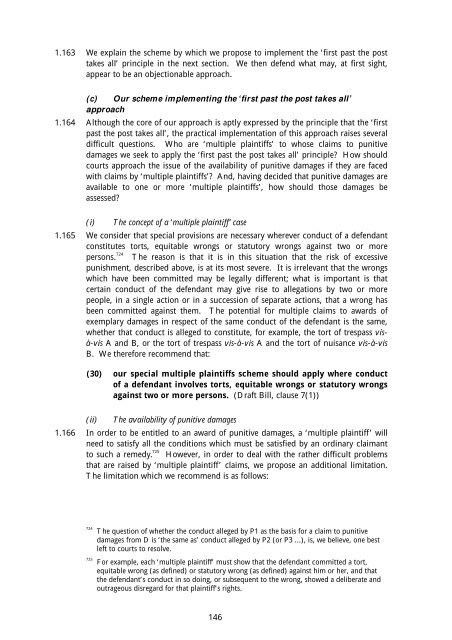Aggravated, Exemplary and Restitutionary ... - Law Commission
Aggravated, Exemplary and Restitutionary ... - Law Commission
Aggravated, Exemplary and Restitutionary ... - Law Commission
You also want an ePaper? Increase the reach of your titles
YUMPU automatically turns print PDFs into web optimized ePapers that Google loves.
1.163 We explain the scheme by which we propose to implement the ‘first past the post<br />
takes all’ principle in the next section. We then defend what may, at first sight,<br />
appear to be an objectionable approach.<br />
(c) Our scheme implementing the ‘first past the post takes all’<br />
approach<br />
1.164 Although the core of our approach is aptly expressed by the principle that the ‘first<br />
past the post takes all’, the practical implementation of this approach raises several<br />
difficult questions. Who are ‘multiple plaintiffs’ to whose claims to punitive<br />
damages we seek to apply the ‘first past the post takes all’ principle? How should<br />
courts approach the issue of the availability of punitive damages if they are faced<br />
with claims by ‘multiple plaintiffs’? And, having decided that punitive damages are<br />
available to one or more ‘multiple plaintiffs’, how should those damages be<br />
assessed?<br />
(i) The concept of a ‘multiple plaintiff’ case<br />
1.165 We consider that special provisions are necessary wherever conduct of a defendant<br />
constitutes torts, equitable wrongs or statutory wrongs against two or more<br />
persons. 724<br />
The reason is that it is in this situation that the risk of excessive<br />
punishment, described above, is at its most severe. It is irrelevant that the wrongs<br />
which have been committed may be legally different; what is important is that<br />
certain conduct of the defendant may give rise to allegations by two or more<br />
people, in a single action or in a succession of separate actions, that a wrong has<br />
been committed against them. The potential for multiple claims to awards of<br />
exemplary damages in respect of the same conduct of the defendant is the same,<br />
whether that conduct is alleged to constitute, for example, the tort of trespass visà-vis<br />
A <strong>and</strong> B, or the tort of trespass vis-à-vis A <strong>and</strong> the tort of nuisance vis-à-vis<br />
B. We therefore recommend that:<br />
(30) our special multiple plaintiffs scheme should apply where conduct<br />
of a defendant involves torts, equitable wrongs or statutory wrongs<br />
against two or more persons. (Draft Bill, clause 7(1))<br />
(ii) The availability of punitive damages<br />
1.166 In order to be entitled to an award of punitive damages, a ‘multiple plaintiff’ will<br />
need to satisfy all the conditions which must be satisfied by an ordinary claimant<br />
to such a remedy. 725<br />
However, in order to deal with the rather difficult problems<br />
that are raised by ‘multiple plaintiff’ claims, we propose an additional limitation.<br />
The limitation which we recommend is as follows:<br />
724 The question of whether the conduct alleged by P1 as the basis for a claim to punitive<br />
damages from D is ‘the same as’ conduct alleged by P2 (or P3 ...), is, we believe, one best<br />
left to courts to resolve.<br />
725 For example, each ‘multiple plaintiff’ must show that the defendant committed a tort,<br />
equitable wrong (as defined) or statutory wrong (as defined) against him or her, <strong>and</strong> that<br />
the defendant’s conduct in so doing, or subsequent to the wrong, showed a deliberate <strong>and</strong><br />
outrageous disregard for that plaintiff’s rights.<br />
146
















